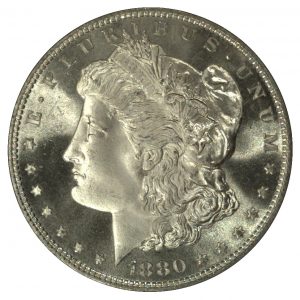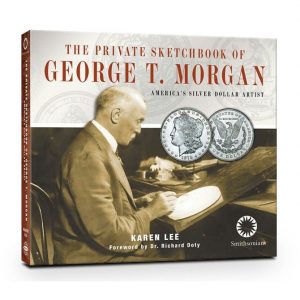Silver Morgan Dollar
Disclosure: We are reader-supported. If you purchase from a link on our site, we may earn a commission. Learn more
The most popular coin in America remains the silver Morgan Dollar. These large coins that contain nearly an ounce of silver prove to be among the most beloved and collected of American coins not only in the U.S. but around the globe. Because so many of the coins were melted down over the years, no one can say with any certainty how many of them remain. Thanks to their relative rarity today, it is difficult to assemble a complete set of them representing all mints and years when they were struck.

Silver Morgan Dollar History and Background
In the mid 1870's, the U.S. Mint decided it was time to bring on a master engraver to create a design for a new silver dollar. The country was not issuing them at this point, but the Mint understood that another silver dollar design would be demanded soon. To find an ideal candidate for Assistant Engraver at the U.S. Mint, H.R. Linderman, Director of the U.S. Mint in Philadelphia, wrote a letter to the Deputy Master of the British Royal Mint. The Royal Mint suggested George T. Morgan, a respected engraver at the Royal Mint who had proven his ability to use his tools to create beauty. Linderman was impressed with Morgan's work samples and gave him the job.
Morgan arrived in 1876 and received the important task of creating the new silver dollar and coming up with half dollar patterns. Morgan's silver dollar design started out as a half dollar pattern. He found Anna Williams, a Philadelphia area school teacher, to be his Lady Liberty model. Her profile was practically a perfect Grecian example. Once Congress passed the Bland-Allison Act in February of 1878 calling for new silver dollars, Morgan expanded his half dollar pattern into full silver dollar size to create the design that became the silver Morgan Dollar.
As impressive 657 million Morgan Dollars were struck during the years ranging from 1878 to 1921. These were minted at all five U.S. mints, a testament to the demand for them in their own time. The mint marks on the coins are no mark for Philadelphia, S for San Francisco, O for New Orleans, CC for Carson City, and D for Denver. Carson City silver Morgan Dollars are generally the rarest of them since smaller numbers were struck at that particular branch.
As few as a million and a half Morgan Dollars may remain. Nearly half of them were melted (270 million of them) by congressional act and order in 1918 to replace the dwindled silver reserves of the U.S. government after the First World War. More were melted down under the 1942 Wartime Silver Act in the Second World War. A final culling of them came as silver was melted and sold during the silver boom of 1979-1980 when the silver prices topped $50 an ounce for a time.
Silver Morgan Dollar Physical Characteristics
The United States Mint guarantees the purity, weight, and content of all Silver Morgan Dollars.
Coin Design
The front side of the coin is known as the obverse. This side showcases the model of Lady Liberty as a Greek goddess. She wears the Liberty Cap that features a ribbon with the word Liberty inside it. This cap is graced by two heads of wheat and two blossoms of cotton. These two symbols represent the agricultural history of the United States. There are also 13 stars to stand for the original first 13 colonies. Morgan's designership is represented by the little initial M found at the bottom of Lady Liberty's neck. The date and national motto “E Pluribus Unum” round off the front design.

The backside of coins is called the reverse in coin terms. An American eagle with its wings stretched out dominates the centerpiece design. In its claws are arrows to represent war and the olive branch to stand for peace. A Gothic script renders the motto “In God We Trust” atop the eagle. The bottom half portion features a laurel wreath surrounding all. Underneath the bow within the wreath is the location for the branch mint mark where the coin was struck. When there is no mark present, the coins were struck at the main Philadelphia mint. Branch mint symbols include D (Denver), S (San Francisco), O (New Orleans), and CC (Carson City). Morgan again claims the design with his miniscule initial M in the left loop of the ribbon that ties the wreath together. This can only be recognized with a magnifying glass because it is so small.
Coin Specifications
- Mass: 26.73 grams
- Diameter: 38.1 mm (1.5 inches)
- Content: 90% silver, 10% copper
- Edge: Reeded
Silver Morgan Dollar Pricing
Every silver Morgan Dollar boast the same face value of $1.00. This means that they can be spent as legal tender anywhere coins are accepted. People do not use them practically for ordinary single dollar purchases. The market value for these coins is substantially higher than the $1 face value.
Face value has no connection to the intrinsic value of a coin. This value goes up and down according to available supply and demand. It is also heavily based on the silver spot price. Silver prices rise and fall on an everyday basis. This means there is some daily change in the value of silver Morgan Dollars too. To obtain current live silver prices, simply go to our home page now.
Investing in Silver Morgan Dollars Through an IRA
The IRS determines which types of silver coins are allowed to be held in self directed IRAs that are often called precious metals IRAs. Besides approved silver coins and bars, approved issues in gold, platinum, and palladium bullion may be contained in these IRAs as well. Setting up one of these precious metals IRAs requires that you purchase at least $5,000 of metals that the IRS approves. Incremental purchases beyond this must be in minimums of $1,000. Physical silver placed in an IRA provides investors with an unparalleled diversification of their portfolio that stocks and bonds simply can not match. Silver makes an interesting and affordable insurance policy since its prices are far lower than gold, platinum, and palladium ones are.
For bullion to be permitted in these self directed IRAs, it has to attain minimum required purity levels. Silver Morgan Dollars meet such criteria with their United States Mint guarantee. These coins must also be kept in IRS approved depositories in order to be a part of an IRA. Such depositories safeguard and inventory all of your coin and bullion holdings. If you have an IRA already, you can roll it over into one of these self directed precious metals IRAs.
The United States Mint does not sell silver Morgan Dollars directly. These must be obtained from a coin dealer or private party. The prices of common issue Morgan Dollars are generally the same. Rare certified Morgan Dollars can cost thousands of dollars and would not be permitted in an IRA as a true collectible item.
Sign up to learn more. It’s free!
If you’re worried about the economy and want to learn tips on how to protect your retirement savings in case of another systemic collapse, sign up to our monthly newsletter now for free! We cover topics such as: precious metals investing, inflation, currency devaluation, national debt, the Fed’s financial policies, world politics, and much more. Join now and we’ll send you a free PDF report entitled “5 scams to avoid when investing in bullion gold & silver”



 Silver
Silver Gold
Gold Platinum
Platinum Palladium
Palladium Bitcoin
Bitcoin Ethereum
Ethereum

 Gold: $3,307.17
Gold: $3,307.17
 Silver: $36.09
Silver: $36.09
 Platinum: $1,351.02
Platinum: $1,351.02
 Palladium: $1,110.25
Palladium: $1,110.25
 Bitcoin: $107,626.91
Bitcoin: $107,626.91
 Ethereum: $2,483.54
Ethereum: $2,483.54